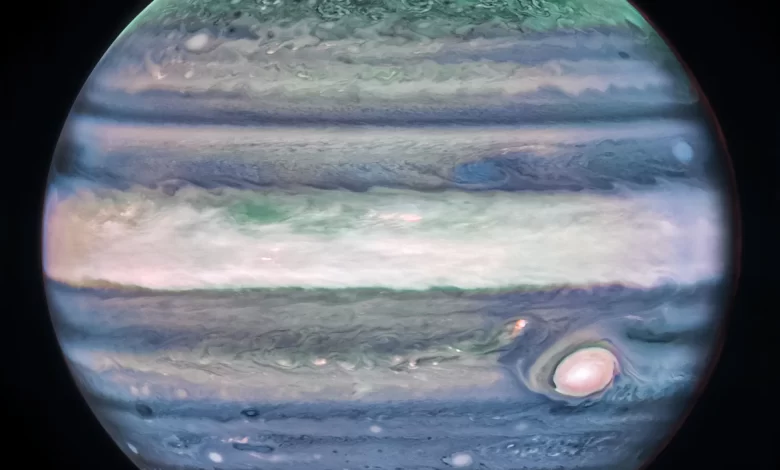NASA’s James Webb Space Telescope Reveals New Jupiter Atmosphere Feature

In an astronomical breakthrough, NASA’s James Webb Space Telescope has unveiled a remarkable discovery within Jupiter’s dynamic atmosphere. The telescope has identified a high-speed jet stream, previously unseen, stretching over Jupiter’s equator and spanning more than 3,000 miles (4,800 kilometers). This revelation sheds light on the intricate interactions of Jupiter’s turbulent atmosphere layers, and emphasizes the unparalleled capabilities of the Webb telescope.
Ricardo Hueso of the University of the Basque Country in Bilbao, Spain, the lead author of the paper detailing the findings, expressed the team’s astonishment, stating, “This is something that totally surprised us. What we have always seen as blurred hazes in Jupiter’s atmosphere now appear as crisp features that we can track along with the planet’s fast rotation.”
The discovery was made by analyzing data from Webb’s NIRCam (Near-Infrared Camera), collected in July 2022. The research forms part of the Early Release Science program, jointly led by Imke de Pater from the University of California, Berkeley, and Thierry Fouchet from the Observatory of Paris. The program aimed to capture images of Jupiter at ten-hour intervals, equivalent to one Jupiter day, in four distinct filters, each tailored to detect changes in small features at various altitudes within Jupiter’s atmosphere.

Image: NASA, ESA, CSA, STScI, R. Hueso (University of the Basque Country), I. de Pater (University of California, Berkeley), T. Fouchet (Observatory of Paris), L. Fletcher (University of Leicester), M. Wong (University of California, Berkeley), J. DePasquale (STScI)
While other telescopes and missions have provided insights into Jupiter’s weather patterns, Webb’s unique perspective explores Jupiter’s high-altitude layers, situated around 15-30 miles (25-50 kilometers) above its cloud tops. The Webb telescope, with its near-infrared capabilities, unveils previously unseen details within the bright equatorial region, where high-altitude hazes typically appear hazy and indistinct.
The newfound jet stream whizzes at an astounding 320 miles per hour (515 kilometers per hour), doubling the sustained winds of a Category 5 hurricane on Earth. It resides approximately 25 miles (40 kilometers) above Jupiter’s cloud layer, in the planet’s lower stratosphere.
By comparing Webb’s high-altitude wind observations to Hubble’s measurements of winds in deeper atmospheric layers, the research team ascertained the speed and altitude at which these winds change, generating wind shears.
Michael Wong, a team member from the University of California, Berkeley, who led the Hubble observations, explained, “We knew the different wavelengths of Webb and Hubble would reveal the three-dimensional structure of storm clouds, but we were also able to use the timing of the data to see how rapidly storms develop.”
The researchers eagerly anticipate additional observations of Jupiter with Webb to ascertain whether the jet’s speed and altitude undergo any variations over time.
Leigh Fletcher of the University of Leicester in the United Kingdom, another team member, shared his insights, saying, “It’s amazing to me that, after years of tracking Jupiter’s clouds and winds from numerous observatories, we still have more to learn about Jupiter, and features like this jet can remain hidden from view until these new NIRCam images were taken in 2022.”
The research findings have been published in Nature Astronomy.
The James Webb Space Telescope is NASA’s foremost space science observatory, unraveling mysteries within our solar system and exploring distant worlds around other stars. It is also dedicated to probing the enigmatic structures and origins of our universe and our place within it. The Webb telescope represents an international collaboration led by NASA in partnership with the ESA (European Space Agency) and the Canadian Space Agency.




